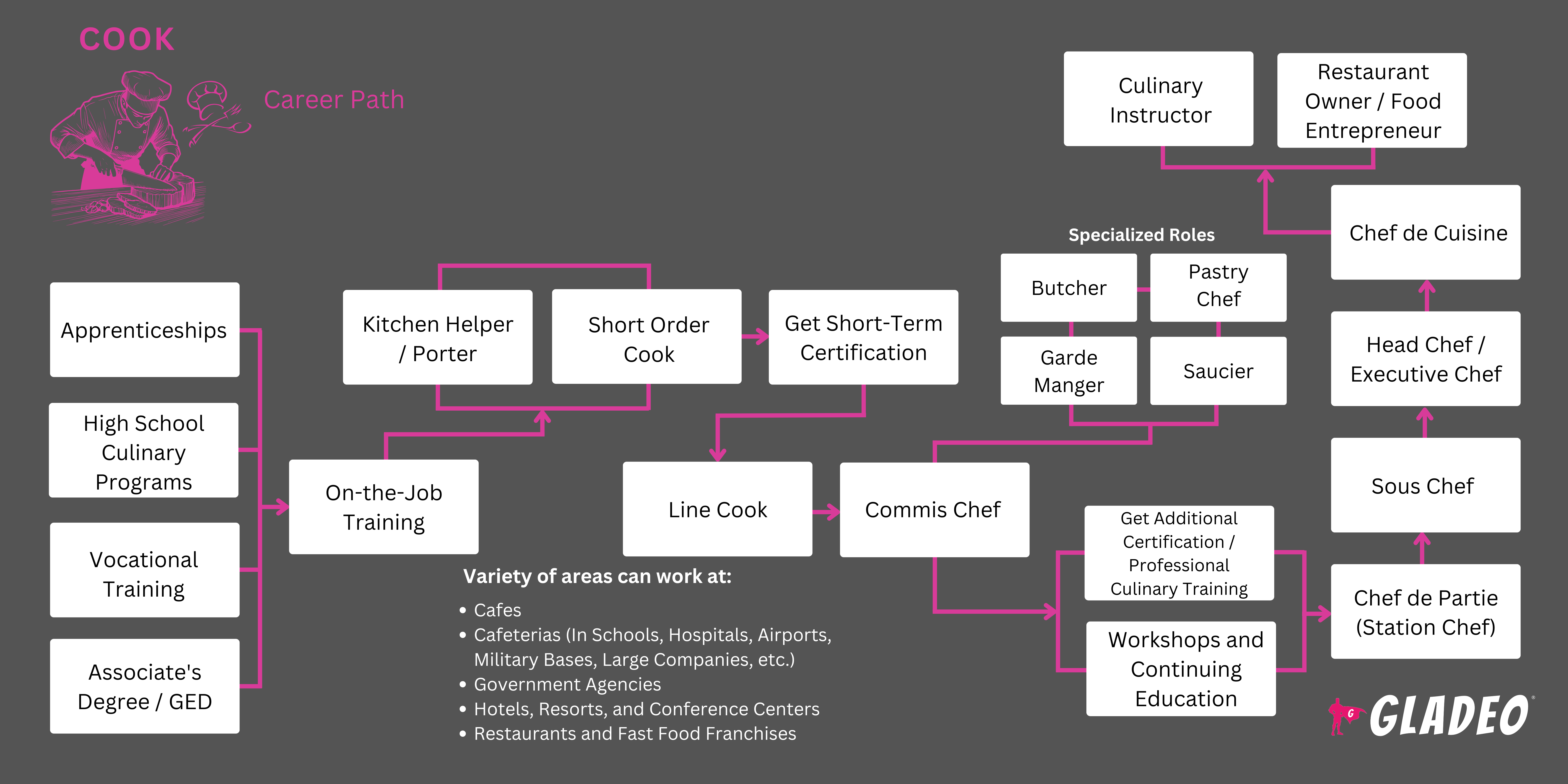Spotlights
Appetizer Preparer, Back Line Cook, Banquet Cook, Breakfast Cook, Broil Cook, Cook, Fry Cook, Grill Cook, Line Cook, Prep Cook, Lead Cook
Going to a restaurant is almost like magic. You sit down, order something from the menu, wait a few minutes…and pretty soon a waiter brings over your dish. On your end, it all seemed pretty easy – but behind the scenes, of course, there are Cooks working hard to prepare each dish that’s being ordered.
Cooks are the backbone of the kitchen, responsible for turning raw ingredients into delicious meals. Whether in a bustling restaurant, a fast food drive-thru, a cafeteria, catering service, or some other dining establishment, they’re crucial to delivering safe, tasty meals to their hungry customers!
While they share certain tasks with chefs, Cooks focus on preparing food using recipes, whereas chefs oversee kitchen operations, menu creation, and culinary innovation. Despite their job title, Cooks’ duties go far beyond just cooking. They organize and prepare the necessary ingredients, closely follow recipe instructions, adhere to strict safe food handling standards, and coordinate with other staff to keep orders flowing smoothly.
It can be a fast-paced job, requiring strong multitasking skills, attention to detail, and the ability to work quickly but accurately so that every dish comes out right!
- Creating delicious meals that people enjoy eating
- Working in a fast-paced, team-oriented environment
- Gaining valuable culinary skills with a potential for career growth
- Millions of job opportunities around the country
Lịch làm việc
- Cooks often work full-time, with possible morning, night, weekend, and holiday shifts.
Nhiệm vụ tiêu biểu
- Prepare kitchen areas for the day, to include sanitizing work areas (to maintain food safety, prevent contamination, and comply with health regulations).
- Prepare commonly used ingredients by thawing, washing, chopping, slicing, and measuring them, as applicable. Follow daily prep checklists to ensure essential ingredients are ready when needed.
- Slice, trim, and portion meats like beef, veal, ham, pork, and lamb.
- Warm up stoves and partially prepare certain commonly ordered dishes in advance, such as daily specials.
- Take orders from wait staff. Follow recipes and portion guidelines, adapting to customer requests, when possible (such as cooking a steak rare, medium, or well done).
- Cook food using various methods, including grilling, frying, baking, and boiling.
- Use timers as needed. Closely monitor cooking times and temperatures.
- Create and arrange appetizers, including relishes and hors d'oeuvres, for service.
- Finish preparing and plating items made from local bakeries, food distributors, and wholesale supplies, such as bread, rolls, desserts and pastries, soups, frozen appetizers, bulk sauces, portioned meats, fresh produce, and dairy products.
- Bake breads, cakes, and pastries from scratch, as needed.
- Taste, smell, or test food with utensils to confirm it is fully cooked and meets quality standards.
- Assist with plating and presentation to ensure visually appealing dishes.
Trách nhiệm bổ sung
- Store food properly to ensure freshness. Check expiration dates. Keep track of inventory so ingredients don’t run out.
- Take care of equipment, pots, pans, dishes, and utensils.
- Dispose of trash properly. Keep storage areas tidy and free from pests.
- Know and comply with health and safety regulations to prevent foodborne illnesses.
- Assist with prep work for catering events or special occasions.
- Work under the direction of chefs and kitchen managers. Learn to prepare new menu items.
- Assist other cooks during high-demand periods or staffing shortages.
- Train new kitchen staff on procedures and best practices.
- Help with pricing items based on ingredient costs and market trends.
- Support a positive, cooperative kitchen environment.
Kỹ năng mềm
- Chú ý đến chi tiết
- Khả năng thích ứng
- Hợp tác
- Định hướng dịch vụ khách hàng
- Efficiency
- Sáng kiến
- Kỹ năng tổ chức
- Sức chịu đựng thể chất
- Giải quyết vấn đề
- Quick decision-making
- Khả năng phục hồi
- Khả năng chịu đựng căng thẳng
- Kỹ năng giao tiếp mạnh mẽ
- Làm việc theo nhóm
- Quản lý thời gian
Kỹ năng kỹ thuật
Cooks need to be familiar with the following:
- Various cooking techniques (e.g. grilling, frying, baking, boiling, roasting, steaming, poaching, sautéing, braising, and sous vide)
- Use of kitchen equipment such as grills, fryers, and ovens
- Knife skills for chopping and slicing ingredients efficiently
Portion control and food presentation - Ingredient storage and shelf life
- Common food allergies and dietary restrictions
- Seasonings
- Sanitation and safe food handling/preparation
- Food safety laws and regulations
- Industry trends and popular menu items
- Cafeterias (in schools, hospitals, airports, military bases, etc.)
- Catering companies
- Corporate dining facilities
- Tàu du lịch
- Cơ quan chính phủ
- Cơ sở chăm sóc sức khỏe
- Khách sạn, khu nghỉ dưỡng và trung tâm hội nghị
- Các công ty lớn
- Dịch vụ ăn uống đặc biệt
Cooks work in high-pressure environments where speed and precision are essential. The work can be physically demanding, requiring long hours on their feet and exposure to heat from stoves and ovens. They have to follow recipes without constantly referencing instructions, work on several dishes at once, and keep up with orders while maintaining food safety and quality.
Kitchens can be noisy, hectic places, so Cooks must be able to focus while also paying attention to what’s going on around them. Since they often use knives, they’ve also got to be mindful not to cut themselves!
Shifts may include early mornings, late nights, weekends, and holidays, which may be a challenge for some lifestyles. In addition, at smaller establishments, Cooks are sometimes on standby to fill in if a co-worker calls in sick.
While some classic dishes will always be staples at any dining establishment, Cooks still have to keep up with eating trends such as plant-based meals, sustainable and local ingredient sourcing, and global fusion cuisine.
A growing emphasis on health-conscious dining is shaping restaurant menus, with an increased demand for low-carb, high-protein, and allergen-friendly options. This shift requires a deep understanding of ingredient substitutions as well as careful preparation to prevent cross-contamination in kitchens. Apart from what dishes to make, Cooks may have to learn ways to make those dishes, thanks to new kitchen technologies like automated cooking systems.
Another trend is the rise of third-party food delivery services like Uber Eats and DoorDash, which has caused many restaurants to see spikes in takeout orders. As a result, Cooks often have to prioritize which meals to prepare first during busy times like lunch and dinner hours. Many kitchens now have dedicated staff or stations to handle online orders efficiently.
Future Cooks may have enjoyed cooking at home, trying new things or watching cooking shows for inspiration. Some may have started working in food service at a young age, gaining hands-on experience in diners or fast-food restaurants.
- Cooks typically need at least a high school diploma or GED. New Cooks often start out as fast food crew members, prep cooks, line cooks, and then short order cooks.
- Many gain hands-on experience by assisting with food prep, cleaning, and simple cooking duties. Some start through high school culinary programs, apprenticeships (such as the American Culinary Federation’s ACFEF apprenticeship program), or vocational training.
- Others may take short-term certifications to improve job prospects, like the American Culinary Federation’s Certified Fundamentals Cook program.
- The Certified Fundamentals Cook program requires a 15-hour course in Nutrition and 15-hour course in Food Safety & Sanitation.
- “Courses are available through the ACF Online Learning Center, ACF approved providers or any academic institution,” notes ACF.
- Over time, Cooks develop skills and advance to higher kitchen roles through on-the-job learning or formal culinary education.
- In general, a college degree isn’t required, but it’s helpful to take cooking classes or attend culinary training programs. Common courses include:
- Basic culinary techniques
- Nghệ thuật làm bánh và bánh ngọt
- Food safety and sanitation
- Nutrition and dietary needs
- Menu planning and costing
- Knife skills and butchery
- Global cuisines
- Certifications in food safety, such as ServSafe, are often required. To advance, additional training or certifications may be needed, such as:
- American Culinary Federation - Certified Culinarian
- National Restaurant Association Educational Foundation - ProStart Certification
- Association of Nutrition & Foodservice Professionals - Certified Food Protection Professional
- National Environmental Health Association - Certified in Comprehensive Food Safety
- National Restaurant Association - ServSafe Food Handler
- North American Association of Food Equipment Manufacturers - Certified Foodservice Professional
- International HACCP Alliance - HACCP Certification for Food Handlers
- American Hotel & Lodging Educational Institute - Certified Kitchen Cook
- Reminder – there’s a difference between a Cook and a chef. Chef positions require more extensive formal training than Cooks.
- As Culinary Lab puts it, “a chef is an individual who is trained to understand flavors, cooking techniques, create recipes from scratch with fresh ingredients, and have a high level of responsibility within a kitchen. A cook is an individual who follows established recipes to prepare food.”
- Thus, it can be said that all chefs are Cooks, but not all Cooks are chefs!
- As mentioned above, Cooks don’t necessarily need any formal training. Many get started by taking entry-level fast food, prep cook, or line cook jobs, then work their way up.
- For those who want to take courses, think about a community college certificate or associate’s, or a certification from a culinary school.
- Check for accredited programs with hands-on training and instructors with real-world experience.
- Look for apprenticeships or internships to gain practical kitchen experience while learning.
- Compare tuition costs and review for any scholarship opportunities.
Cooks do not need a college degree for their jobs, unless they want to advance to a chef position. Training options include, but are not limited to:
- Taking courses at a vocational school or community college
- American Culinary Federation’s ACFEF apprenticeship program, Certified Fundamentals Cook program, and Certified Culinarian program
- National Restaurant Association Educational Foundation - ProStart Certification, “a two-year, industry-backed culinary arts and restaurant management program for high school students.”
- National Restaurant Association - ServSafe Food Handler
- North American Association of Food Equipment Manufacturers - Certified Foodservice Professional
- International HACCP Alliance - HACCP Certification for Food Handlers
- Take cooking or nutrition classes if available.
- Volunteer to help cook at home or with community organizations. Get a safe food handlers certificate, if needed.
- Work part-time in a restaurant, bakery, or catering business.
- Learn about food safety and proper kitchen procedures.
- Read cookbooks and cooking magazines and blogs. Watch cooking videos and TV shows.
- Note, the list of books, blogs, magazines, YouTube tutorials, and TV series about cooking is too extensive to get into here, but see our list of Resources for some ideas!
- Seek mentorship from experienced cooks or chefs.
- Volunteer for school activities where you can practice soft skills, including verbal communication, teamwork, and project management
- Ask a few working Cooks in your area if you can do an informational interview.
- Keep a draft resume that you can add to as you gain experience.

- Apply to entry-level positions, such as prep cook or line cook, at local fast food restaurants, diners, cafes, or catering businesses.
- Note, smaller, less busy establishments are probably more likely to hire someone new than a large, busy dining facility.
- Upload your resume and set up notification alerts on Indeed.com and other job portals.
- Also check out job listings on Craigslist, which many small businesses use instead of Indeed and larger job portals.
- Make sure your resume is error-free, engaging, and filled with stats and impacts. Include keywords like:
- Culinary techniques
- Chuẩn bị thức ăn
- Quản lý hàng tồn kho
- Kitchen safety
- Lập kế hoạch thực đơn
- Plating and presentation
- Recipe development
- Sanitation standards
- Team collaboration
- Ask people in your network if they know about job openings. Many Cook jobs are found through word of mouth.
- Make a list of personal references who employers can contact to ask about your work ethic and experience. Be sure to get permission from them before giving out their phone numbers or email addresses.
- Check out Cook resume templates and sample interview questions such as “Explain the difference between broiling and braising.” or “How do you keep your line cook skills up to date?”
- Be ready for a working interview or cook test to demonstrate practical experience.
- As Testlify writes, “This [cook] test serves as a valuable tool in the hiring process for establishments such as restaurants, hotels, and catering companies, ensuring the selection of highly skilled and competent cooks. This test is needed when hiring cooks because it allows employers to assess candidates’ proficiency in the skills required for successful culinary operations.”
- Note, an optional portfolio may be allowed. If so, consider making a portfolio to showcase:
- Photos of plated dishes to highlight presentation skills.
- Sample menus or meal prep plans.
- Certifications like food safety training (e.g., ServSafe).
- Letters of recommendation from past employers or colleagues.
- A list of skills such as grilling, sautéing, baking, or other techniques.
- Be familiar with the restaurant you’re interviewing with. Study their menu, look at their history, read the bios of their owners and top cooks, and be ready to explain how you see yourself fitting in.
- Always be on time for your shift and ready to go. Demonstrate reliability, teamwork, efficiency, and a commitment to safety and sanitation.
- Talk to your supervisor about advancement opportunities. When ready, ask to take on more responsibilities, such as training new staff or assisting with menu development.
- Earn certifications to improve job prospects and promotion potential. Consider attending culinary school or taking advanced courses.
- Continue to grow your experience by trying new things. Master different cooking techniques and cuisines.
- Keep learning by reading books and articles, talking with peers, and taking courses to keep your skills sharp.
- Develop strong knife skills and efficiency in food prep.
- Stay informed on industry trends and food innovations.
- Engage with industry-related organizations like the American Culinary Federation by attending events and networking to learn and build your social capital.
- If you’re up for it, craft a business plan, secure investors, and launch your own restaurant!
Trang web
- ACF Certified Culinarian program
- ACF Certified Fundamentals Cook
- ACFEF Apprenticeship Program
- AllRecipes
- Liên đoàn ẩm thực Mỹ
- Viện Tiêu chuẩn Quốc gia Hoa Kỳ
- America’s Test Kitchen
- Association of Nutrition & Foodservice Professionals
- BBC Good Food
- Bon Appétit
- Epicurious
- Food Network
- Hội đồng quốc tế về khách sạn, nhà hàng và giáo dục thể chế
- Hiệp hội quốc gia về dịch vụ ăn uống và sự kiện
- Hiệp hội nhà hàng quốc gia
- Quỹ giáo dục Hiệp hội Nhà hàng Quốc gia
- Hiệp hội các nhà sản xuất thiết bị thực phẩm Bắc Mỹ
- NYT Cooking
- ProStart Certification
- Serious Eats
- ServSafe Food Handler
- Simply Recipes
- Hiệp hội Quản lý Khách sạn và Dịch vụ Thực phẩm
- The Kitchn
Sách vở
- How to Cook Everything: The Basics: All You Need to Make Great Food – With 1,000 Photos: A Beginner Cookbook, by Mark Bittman
- The Flavor Bible: The Essential Guide to Culinary Creativity, Based on the Wisdom of America’s Most Imaginative Chefs, by Andrew Dornenburg and Karen Page
- The Science of Cooking: Every Question Answered to Perfect Your Cooking, by Dr. Stuart Farrimond
Being a Cook can be a tough gig, with long hours on your feet in hectic (and often hot) environments. For those looking for something a bit different, some popular related careers include:
- Người làm bánh
- Bartender
- Butcher
- Đầu bếp
- Dietitian
- Công cụ lập kế hoạch sự kiện
- Food Product Demonstrator
- Food Safety Inspector
- Nhà khoa học thực phẩm
- Food Server
- Quản lý nhà nghỉ
- Pastry Chef
- Quản lý nhà hàng
- Giám đốc bán hàng
- Sommelier
- Wait Staff
Nguồn cấp tin tức

Việc làm nổi bật

Các khóa học và công cụ trực tuyến







